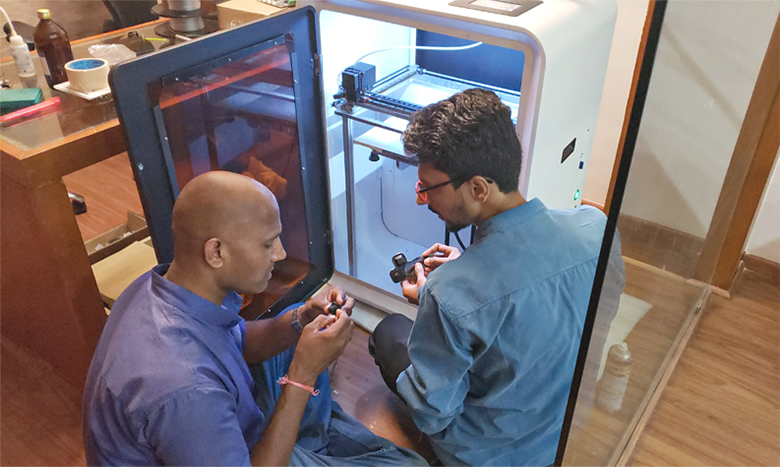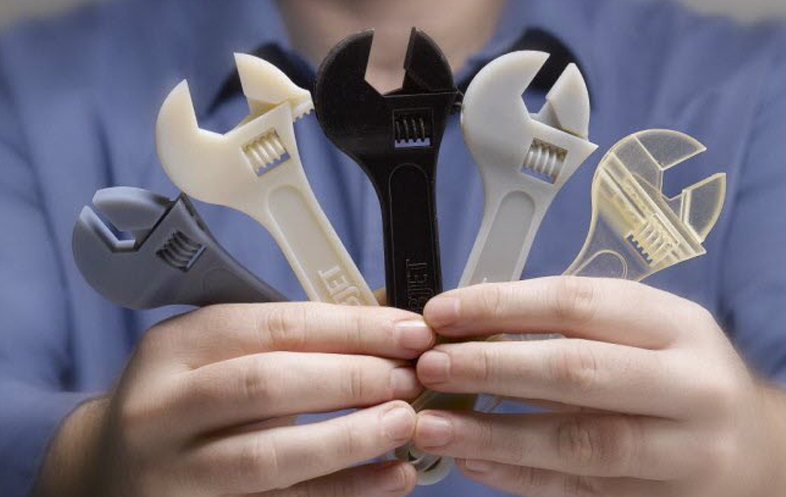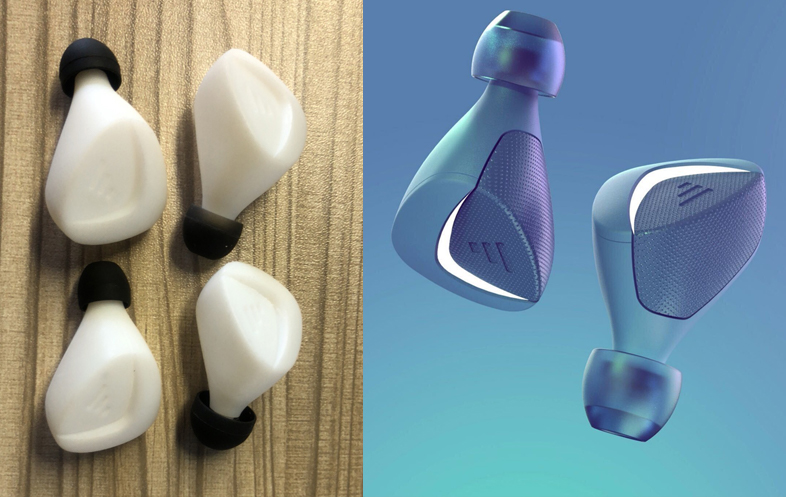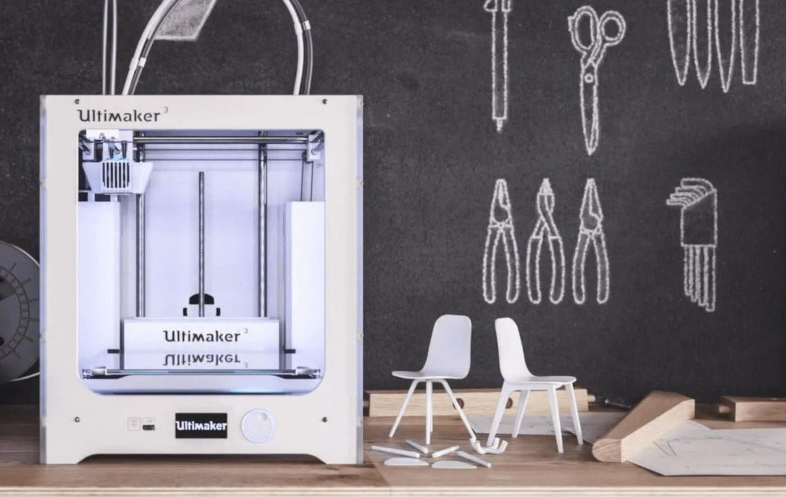Before 3D printing came along, industrial designers carved foam, machined wood, and molded clay, which were all slow and labor-intensive processes. It’s no wonder that this industry was quick to embrace 3D printing.
Here we talk with leading industrial designers about how they use 3D printing, which printers they rely on, and their advice for getting the most out of a printer purchase.
3D Printers: A Tool of the Trade

Although there may not be a 3D printer in every industrial design firm yet, the technology’s popularity is taking off because it’s more affordable and more approachable than ever before, designers say.
“In my career, I’ve seen 3D printers go from being a bit of a novelty, to an expensive tool, to more of an essential part of design services,” says Nathan Pollock, founder of Katapult Design in Byron Bay, Australia. “Greater reliability, better UX, and much better quality have all had a big impact on acceptance.”
Several printer manufacturers are targeting the business user with easier-to-program machines, a wider range of materials, and integrated ecosystems of software, materials, and training. These advancements, along with lower prices, have attracted a loyal and growing audience of professionals.
“At this time, in product design, 3D printing has become a tool of the trade,” says David Block, principal of Studio Redeye in Brooklyn, New York. “If you do not have a 3D printer, and you are in the product development space, you are behind,” echos Jonathan Thai, co-founder and partner of HatchDuo in San Francisco.
Accelerate Your Product Design

Among the technology’s advantages, 3D printing is integral to revving up the entire creative process, designers say.
“The top advantage is primarily the speed,” says Pollock. “We can get quick, concept-level evaluations and adjust or refine our thinking immediately.”
Katapult Design is currently developing a closure for a baby wipes container, and being able to rapidly 3D print and test variants on the design was extremely helpful in getting the client a quick and cost effective solution, says Pollock.
Beyond initial proofs of concepts, 3D printers can deliver functional mechanical parts and intricate multi-component prototypes. In fact, designers say they’re able to get closer to final product look, feel, and functionality with 3D printing than with any other type of in-house prototyping method.
“We print everything from quick block models to test the form and proportions of a design, through to high-fidelity working prototypes that allow us to perfect a detail or a mechanism,” says Oscar Daws, director of Tone Product Design in London. “3D printing allows us to rapidly iterate complex shapes and accurate details, which means we don’t have to compromise on the design of a prototype in order to physically test it.”
For Tone’s design of Joseph Joseph’s new hanging storage canisters (pictured above), the design team used 3D prints from the start to experiment with multiple options for the product proportions. “Once the initial design concept had been developed, we used high resolution SLA prints to refine the technical detailing and test the CAD data prior to manufacture,” he says.
Tone run their resin printer from Formlabs and an Ultimaker S5 filament printer several times a week, churning out iterations of everything from innovative kitchen gadgets to electronic devices.
Show, Don't Tell, With Printed Prototypes

“In-house 3D printers enable us to show clients physical representations of their future products and the design engineering work we have completed to date,” says Lucas Lappe, partner at Doris Dev in New York City. “3D printers have kept us ahead of the competition, and without 3D printed prototypes, clients often do not understand where their products are in development.”
At Inventindia Innovations, one of the largest industrial design firms in India, CEO Sanandan “Sandy” Sudhir is similarly dependent on his 3D printers. “With almost 40 ongoing projects at any given point in time, 3D printing is super critical to all our projects without fail,” he says. “We use 3D printed parts very early in our design process to make some quick proof of concept models, and, at a later stage, for more refined parts to assemble the first-level functional prototypes.”
Inventindia has used a range of 3D printers over the years and currently runs a collection of larger-format filament and resin printers from Mingda. “3D printing technology has evolved quite a bit over the last 20 years,” says Sudhir. “The older technologies, like FDM, SLA, and SLS have become very popular and cost-effective, and you can buy an FDM 3D printer for as low as $300. On the other hand, the more advanced technologies from HP and Objet, that allow for multiple materials and colors seamlessly integrated in a single part are more expensive, but allow a lot more flexibility in terms of explorations and possibilities to create appearance models.”
Arguably, every 3D printing technology is applicable to industrial design, even metal 3D printing, which Inventindia outsources occasionally to a 3D printing service provider.
Outsourcing Industrial Design Models

Industrial design firms don’t need to own their own 3D printers to benefit from the technology. There’s been a boom in 3D printing services worldwide, including Jawstec and Sculpteo, and 3D printing service comparison platforms, such as Craftcloud.
These services, collectively, offer designers the ability to order parts in materials ranging from rubbery plastics to polished steel, and in sizes up to more than a meter square.
Ordering a part from a professional service saves money in the short run over buying your own printers, and can even be faster than printing in-house. In addition to offering a wider variety of technologies than most design firms can afford to maintain in-house, many printing services offer guidance to ensure your print comes out exactly as expected.
However, in the longer term, “in-house printing should save you some in print costs, and really save you shipping costs for all those parts, and lead times,” says Ian Peterman, CEO of Peterman Design in Los Angeles.
Designers still turn to service providers because of the complexity of 3D printing, but many professionals today say that’s no longer a big issue.
“Every engineer at the company is trained to manage the 3D printers,” says Lappe. “This gives everyone who designs and is working with 3D printed prototypes and understanding of the process.”
Lappe has worked with industrial 3D printers from Stratasys, including the Fortus and Connex FDM printers, but during the pandemic, when his company’s office closed, he and other designers were able to continue working by bringing home Formlabs Form 3 resin printers because they are small and portable, he says.
3D Printer Purchasing Advice

The various 3D printing technologies and printer brands offer different advantages and disadvantages in terms of available materials, the quality of the final printed parts, ease of use, printing speed, and cost. It can seem like a maze of confusing terminology and characteristics to the uninitiated.
“Carefully consider what you will be using it for, as this will have a big impact on the technology you choose,” says Daws. “For industrial designers, I’d suggest starting with a high quality FDM printer, which will allow you to do most things quickly and relatively cheaply.”
FDM (fused deposition modeling), or machines that print with a spool of plastic filament, can range from a few hundred dollars to a few thousand. Materials choices range from soft pliable plastics to super strong plastics and there are also recycled and sustainable options.
“We prefer to use normal FDM printers for preliminary proof of concept models so that we can do quick and dirty prints and test our ideas,” says Sudhir.
FDM is the most common type of 3D printer and the easiest to master and maintain.
“Buy something that everyone on your team can use,” says Lappe. “Something that is easy and does not require a dedicated technician. That allows more people to use the printer and makes it a part of everyone’s workflow.”
Another type of printer popular with industrial designers is a resin printer, otherwise known as stereolithography or SLA. These printers use a vat of liquid resin and generally produce finer details and smoother surfaces than FDM.
“SLA printers are good for using transparent materials to understand fit and finish related issues as well as mechanical interference with the internal parts,” says Sudhir. “But generally SLA parts are brittle, so they are not appropriate for simulating the exact material properties of plastic parts.”
Although most SLA materials, or resins, are brittle, some are flexible and elastic, and manufacturers are rapidly expanding their offerings to meet growing demand for textures, colors, and strength.
Designers Hope for Future Printer Improvements

Despite the near-ubiquitous presence of 3D printers at industrial design firms, they haven’t solved every prototyping problem.
“We still have to get a lot of final prototyping done using CNC machines that we outsource, and we are waiting for a time when 3D printing would match up both in terms of finish as well as structural strength,” says Sahdir.
“We love the ability to print in soft material, so our hope is to see more improvements to the soft rubber elastomeric materials because we do a lot of earbud- and headphone-related projects,” says Thai.
A common complaint with FDM prints is the sanding and polishing or painting that’s necessary to achieve smooth surfaces, which adds time and labor to prototypes.
“I’d love to see smoother walled options without post print work so things like drafts with smooth walls could be better tested before injection mold production starts,” says Peterman, who plans to grow his firm’s 3D printing capacity in 2021 by adding more 3D printers.
Pollock at Katapult Design is also planning on buying more printers in 2021. “Most probably our new printers will have different technology, to cover a broader spectrum of requirements,” he says. Meanwhile, Lappe says his firm has its eye on adding a Formlabs Form 3L, large format resin printer to its in-house capabilities.
Industrial designers were among the early adopters of 3D printing and will likely continue to be a testing ground for new technologies and materials.
Lead image source: (Source: HatchDuo, San Francisco)
License: The text of "How Industrial Designers Embrace 3D Printing" by All3DP Pro is licensed under a Creative Commons Attribution 4.0 International License.


